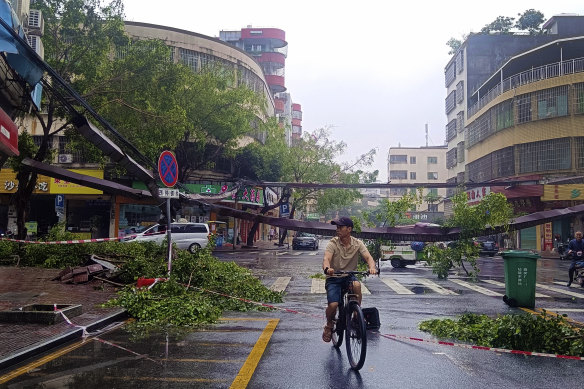
Floods also battered neighbouring Jiangxi province. CCTV, citing the Jiangxi Provincial Flood Control and Drought Relief Headquarters, said 459 people had been evacuated. Rains and floods have affected 1500 hectares of crops in the province and caused financial losses of more than 41 million yuan ($9 million).
In Qingyuan, a relatively small city of 4 million, residents counted their losses.
“My rice fields are fully flooded, my fields are gone,” Huang Jingrong, 61, said.
Huang was sheltering under an overpass with other farmers from his village, alongside an assortment of personal belongings, including a washing machine.
“I won’t be making any money this year, I will be making losses,” he said, estimating his losses at about 100,000 yuan. “What can we do? We won’t get reimbursed for our losses.”
Over the weekend, waterways in Guangdong overflowed including the river near Huang’s village, where waters have reached the second storey of houses after washing out paddy and potato fields.

A cyclist rides past fallen debris and trees in the aftermath of heavy storms in Qingyuan, Guangdong province.Credit: AP
In other parts of Qingyuan, rescuers tackled neck-high waters to extract residents including an elderly lady trapped in waist-deep water in an apartment building.
Others remained on the upper floors of their houses, waiting for the waters to recede as friends delivered food by boat.
Before 2022, it rarely rained as heavily as it does now, and the floodwaters were never as high, said Qingyuan resident Lin Xiuzheng, an online retail sales worker.
Weather events in China have become more intense and unpredictable because of global warming, scientists say, with record-breaking rainfall and drought assailing the world’s second-largest economy, often at the same time.
Precipitation records for April have been broken in many parts of Guangdong, with the cities of Shaoguan, Zhaoqing and Jiangmen to the west and north of Guangzhou also half-submerged in floodwaters.
Across the province, 36 houses collapsed while 48 were severely damaged, resulting in a direct economic loss of nearly 140.6 million yuan ($30.5 million), Xinhua reported.
Two companies said there had been no immediate impact to business or supply chains.
“Everything’s running as usual and everyone got to work,” said a person who answered the phone at Camelot PCB, a print circuit board company that supplies Tesla and other electric vehicle makers.
Polyrocks Chemical, a plastics company that supplies technology giants such as Apple, Huawei and Samsung, also said its operations were not affected.
Loading
Many rivers remain swollen, however, at levels above safety thresholds, with rainfall in recent days two to three times what is considered normal at this time of the year.
The intense convective weather in southern China was caused by a stronger-than-normal subtropical high, a semi-permanent high-pressure system circulating north of the equator.
The subtropical high led to warmer temperatures that drew in more moisture-laden air from the South China Sea and the Bay of Bengal, Chinese meteorologists said, resulting in the intense precipitation. Rain is expected to affect Guangdong until the end of April.
Reuters, AP
Get a note directly from our foreign correspondents on what’s making headlines around the world. Sign up for the weekly What in the World newsletter here.



























